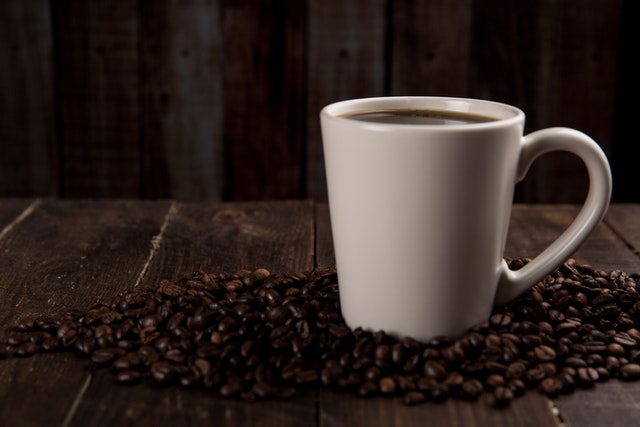
Can you put coffee grounds down the sink?
If you are like me, the smell of fresh coffee permeates your home every morning when you are getting ready for work. It is important to me that I start my day off on the right foot (and with a cup of coffee in hand).
As much as I love drinking coffee, it can be a real pain in the kitchen. Coffee grounds strewn all about are messy and there is always the risk of accidentally pouring too many grounds into your mug. While some people enjoy decorating their homes with trinkets and other knickknacks, anything more than occasional spills makes my wife uneasy… so out went the decorative china cups! That being said, I have to admit not everything gets cleaned up quite as quickly. Coffee grounds in the sink can be a real pain to get rid of.
Table of Contents
Why you should not put coffee ground down the sink?
Coffee inevitably makes its way down your drain eventually. If you are not careful enough about how much water you are running while cleaning up there’s a good chance it will take the ground down with it… right? Coffee grounds are notoriously known for causing drain clogs that can mean calling the plumber out to clear it… but not this time!
Coffee grounds are great at absorbing fats and oils. Coffee grounds get rid of them by trapping them in the grinder, but ours is hiding down in the sink waiting for a chance to be taken away. When coffee grounds get carried down your drain they dry out over time, especially if you’re lucky enough to have the water levels high enough for them to float around in. Because of this, coffee grounds are actually quite good at trapping messy kitchen waste that has made its way into your disposal system – preventing odor build-up that might otherwise come from food or other leftovers going “bad”. Coffee ground drains are a thing of the past. Coffee grounds are a great, eco-friendly alternative to chemical drain cleaners and other additives. Coffee filters can also be used as a natural coffee substitute in your garden! Coffee grounds make soil more acidic which can help with plant growth for those plants that enjoy slightly lower pH levels. Coffee filter flowers look particularly nice as an adornment to potted plants because they filter water very well preventing it from running off the coffee ground based substrate before it’s been fully absorbed by the soil. Coffee filters bind together quite quickly after being watered once or twice making them perfect as part of a composting system for flower gardens where you might otherwise use peat moss or mulch as compost filler!
Helpful ways to use coffee ground
Here a few things you can make with coffee ground to save the environment and reduce waste:
Make composite from coffee ground
Coffee drinkers are not alone, however. Coffee grounds might seem like a waste product but they make great compost add-ins for your garden! Coffee is particularly rich in nitrogen and potassium – perfect additions to fertilisers for roses and other plants that prefer slightly acidic soil conditions (which include most flowering plants). As such, many people recommend using coffee grounds as mulch or even growing an entire plant from them!
Coffee is an important source of antioxidants
If you are like me, you probably do not want to let your coffee grounds go to waste. Coffee grounds are easy enough to dispose of in the trash but they are so much more versatile than that! Coffee is an important part of my daily routine… and by extension, so am I! Coffee makes up a large part of my diet (or at least it is on my mind) – but I drink decaf these days because caffeine is not great for me. Fortunately there are plenty of other uses for totally normal things like mocha bars. Coffee can be used as a food flavoring agent, particularly dark chocolate. Not only does this make for some great tasting snacks (try mocha sauce on top of vanilla ice cream) it also explains why you are always hungry at 1AM.
Coffee is also an important source of antioxidants, which can help fight cancer and other diseases (though you should talk to your doctor before making any significant dietary changes).
Coffee is an essential part of my diet – but if you want to make sure you get the right amount it’s worth getting yourself a coffee scale. Coffee scales are available in all different shapes and sizes and most of them will tell you everything from how much caffeine you are had today down to the exact altitude where the crop was grown!
Coffee grounds can be used for more than just growing plants though; they are actually pretty good for exfoliating! Coffee grounds have natural acids that remove dead skin cells, helping to reduce their build-up on your face and hands. Coffee is a great way to get rid of those dead skin cells, but you can also use it for your hair! Coffee grounds are especially good at making hair shiny because caffeine helps to open up the cuticles on your hair – making it look more vibrant.
Coffee was one of the first things that started me down the path to trying new things, trying weird foods and generally becoming more aware of what goes into my body every day… so I sometimes wonder if it is actually responsible for my caffeine addiction. Coffee makes its appearance in many popular movies – particularly comedies like The Big Lebowski.
Can you put coffee grounds down the sink? Coffee has always been part of my daily routine but lately I have realized just how much better it tastes when someone else makes it for me. Coffee has always been my go-to pick-me-up in the afternoon – and it is my favourite way to relax in the evening too. Coffee is one of those things that I cannot imagine not being a part of my daily life, even if my enjoyment of it has waned since my youth when I drank mocha bars on a regular basis! Coffee grounds are amazing for your garden and they are an underutilized waste product too… so what are you waiting for?
Why coffee ground can be good for plant?
We surely drink too much coffee in the morning, which is not good for our health. For environmental protection, people then try to find ways to reduce wastes. Coffee ground can be one of these. Here are some benefits that you may not know:
Make soil lighter and smoother
If you dump your coffee grounds in your garden, this will make the soil fluffier, breathable and less compacted after watering plants. This is because coffee ground contains nitrogen compounds which break down rapidly by microorganisms present in soil thus generating carbon dioxide naturally. Without piling up uselessly on sidewalks or clogging drainage systems, it adds fertility to the soil while being able to decompose easily when dumped at home gardens or farmlands.
Prevents soil erosion and landslides
Heavy rains can cause soil erosion, and this is often worse when the soil is bare. Coffee ground applied to the surface of the soil can help reduce water runoff and prevent soil erosion. It can also help keep the soil in place on steep hillsides that are prone to landslides.
Suppresses weed growth
Weeds compete with desirable plants for water, nutrients, and sunlight. By applying coffee ground to the soil, you can suppress weed growth and give your plants a better chance of thriving. The coffee grounds will also add nitrogen and other nutrients to the soil, which will benefit your plants.
Makes your flowers bloom better
Adding coffee grounds to your garden will give your plants more nutrients, which they can use to grow bigger or better blooms. It will also keep the soil moist for longer periods of time, so that your flowers have more time to develop.
Keeps slugs away
Slug is a common pest in most parts of the world. Slugs are attracted to beer but coffee deters them according to certain publications on the web. You can try putting used grounds where slugs are known to appear and see if it keeps them off your vegetables.
Keeps Aphids away
Aphids suck sap from fruit trees and other ornamental plants, including roses and hydrangeas among others, weakening leaves and causing distorted flowers as well as black leaves. Sprinkling coffee grounds around the base of these plants can help deter aphids from settling there and causing damage.
It is free
That is right – you can get all of these benefits simply by saving your coffee grounds instead of throwing them away. If you have a garden, save your coffee grounds and add them to the soil to see how they improve your plants’ health!
Steps to turn coffee ground into fertilizer
The first thing you will need is a container, such as a plastic bag or even an old sock would do just fine. The next step is to add your usual amount of coffee grounds into the container, then add water until everything has been well blended to produce a nice smooth consistency.
After this initial mixture, simply grab some cheesecloth and strain out all of the liquid. Once done, let it sit in order for it to lose any excess moisture and produce a nice moldable texture that can be used in many different ways.
If you find yourself with extra moldable material after str all of the liquid away from your mixture, you can simply save it and use it as a nice filler for your flower beds or perhaps even create some fun little shapes to put around the garden.
Hanging baskets are another area where this moldable material will come in handy. Simply fill a section of a hanging basket with your mixture and place your favorite plants inside. You could also experiment by using different types of plants in order to determine which ones seem to do the best. Once completed, be sure to water as normal and keep an eye on them throughout the springtime season as things begin to grow once again.
The next option is something that kids would really love because they can play with this material quite easily without worrying about getting their clothes dirty or ruining anything else within the area surrounding their play area. Simply fill a small moldable plastic container or even a plastic bag with your coffee ground/water mixture and place it out for the kids to play with. They will have fun building shapes, using it as a nice canvas for painting pictures and even telling stories based on what they have created if they prefer not to paint something onto their new creation.
The last option is to simply use this material as you would any other type of fertilizer in order to keep all of your flowers healthy and full of life at all times throughout the springtime season. For example, create a few holes within your flower beds that are about one inch deep then fill those holes up with this material after everything has been completely dried from strained of excess water.
If you choose to use this material as fertilizer, make sure that you actually water it down after applying it within your flower beds. Failure to do so will result in the perfect environment for weeds to grow on top of your coffee ground/water mixture if they are not watered before hand.
Can you put coffee grounds down the sink? With all of these different options available for how to recycle coffee grounds and turn them into fertilizers, you may find yourself wondering why you would even bother buying an actual bag of fertilizer next time you run across some at the local garden center.
How to Grow Mushrooms in Used Coffee Grounds?
Mushrooms only thrive in specific conditions and they are notoriously difficult to grow. For starters, mushrooms do not like the taste or smell of ordinary garden soil (because it contains nutrients that reduce their growth rate). They also need a different type of substrate than what most plants use – something with lots more protein content like used coffee grounds!
Used Coffee Grounds make an excellent base for growing mold fungus on because there is already been plenty time spent sterilizing them during brewing process; another step you might have taken if planning on growing yours would have been required otherwise
Collect about 5.5 pounds (2.5 kg) of grounds and moisten them using a spray bottle.
Add a little over 1 pound (500 grams) of mushroom spore and sawdust mixture and mix well. You can look for this product at your local gardening store.
Place resulting mixture into a filter patch grow bag, large freezer bag or bucket and fill until approximately one-half to two-thirds full.
Cut four air holes, about 5 mm in size, into the sides of your container above the grounds. If you are using an open container, cover it with cellophane and poke with a few more small air holes.
Lightly spray the grounds with water once daily or as needed to keep them moist.
In about two to four weeks when you start to see dense white areas with little budding mushrooms, move the container to an area with lighter and fresher air.
When the mushrooms become plump and their caps turn upward, you can harvest them.
Can you put coffee grounds down the sink? You can use this method to grow just about any kinds of mushroom, but shiitake and oyster varieties seem to be the easiest.
Making Body scrubs from coffee ground
Body scrubs are used for exfoliation. Coffee ground is the key ingredient of coffee scrub, which provide a variety of benefits including removal of dead skin, improving cellulite and reducing acne scars.
What you need: 100g dark coffee ground
4 tbsp light oil/liquid oil (almond, jojoba or olive oil)
1 tbsp honey
2 tbsp brown sugar or granulated sugar (optional)
Essential oils, dried flowers (optional)
To use as natural sweetener instead of sugar, use 1/3 cup xylitol. Do not substitute with stevia.
How to make it
1). Mix together all ingredients except essential oils in a bowl until all ingredients are well combined.
2). Add essential oils if using, dried flowers (optional), and other natural ingredients like chia seeds or dried nuts (optional) to your mixture. The amount of other ingredients you choose to add is up to you. For example, some people prefer completely oil-based scrubs while others prefer a lighter mix with more grains. It’s all up to your personal preference!
3). Store the scrub in an airtight container for up two weeks or longer if stored in the refrigerator. Please note that oils will harden when chilled so allow it to sit at room temperature before using. If using xylitol as sweetener, do not refrigerate as the sweetness may crystallize and become slightly grainy.
How to use
Use about a quarter-sized amount on wet skin and gently massage in circular motions. Rinse off. Use as desired.
Benefits
It works like many commercial body scrubs only better! This nontoxic scrub removes dead skin cells without worrying about any harmful chemicals or additives. The sugar (or xylitol) helps loosen up dry skin, exfoliating the area while the oil softens it all up again afterwards, preparing skin for more moisture and further exfoliation. Don’t worry if you’re not a fan of coffee – this recipe is also great with coconut oil instead of the coffee grounds! Here are some benefits from using homemade body scrubs:
Helps remove dead skin cells
Helps with cellulite, stretch marks and acne scars
Can you put coffee grounds down the sink? It helps reduce clogged pores that may lead to blemishes or breakouts due to the natural exfoliating effect of sugar. Coffee is also known to help prevent breakouts so this may be your secret weapon in fighting acne! If you don’t like coffee or it irritates your skin, there are other recipes out there using different oils instead for you to try.
Helps moisturize skin
Treat Under-Eye Circles from coffee ground
Coffee is a great way to reduce under-eye circles. The caffeine in coffee helps tighten skin and reduce swelling around your eyes, while the dark liquid itself also lightens up dark circles.
Here is what you need: One tablespoon of cold coffee, half teaspoon of honey, one egg white and two cotton swabs or gauze pads.
When the egg whites are fluffy, add the honey to it. Add cold coffee until mixture becomes thick paste with no lumps left inside it. Apply this mixture on your eyelids after cleaning them properly then leave it for 15 minutes till it dries up completely on your skin then wash away with warm water.
Repeat this procedure 3 times in a week for better results.
If you have dry skin, then you can use olive oil or almond oil before applying this mixture. You can also store the coffee paste in fridge for about a week.
Coffee is known to have anti-inflammatory properties that help reduce puffiness and dark circles around the eyes. Honey has anti-aging properties while egg whites are rich in proteins and vitamins that are beneficial for the skin. Cotton swabs or gauze pads will help in applying the mixture evenly on the eyelids.
Can you put coffee grounds down the sink? This remedy is simple, easy to follow and does not require any expensive ingredients. So, next time when you have some extra coffee grounds, do not discard them! Use them to get rid of those pesky under-eye circles.
Neutralize Odors is made by coffee ground
There are many ways to use coffee grounds around your home to kill odors naturally. However, keep in mind that they will only work if the odor is caused by bacteria. Soap scum won’t be affected by the smell of coffee!
You can also use this method outside to get rid of garden pests. Coffee ground mixed with water will attract slugs away from your prized plants. Just mix up about 2 tbsp of each ingredient in an empty spray bottle and fill it with water, then shake well. Spray the mixture on all of your plants to keep bugs away.
Can you put coffee grounds down the sink? You can also use coffee grounds outdoors to make a natural fertilizer or insect repellent. Just mix some coffee grounds with water and pour it around the base of your plants. Or, you can place them near entry points for ants, slugs, earwigs, snails and other pests.
Using coffee Grounds in the Shower
The smell of coffee is great for your morning rituals, but it can also be used to help you wake up in the evening. Simply drop a small amount of fresh coffee grounds into an old pair of pantyhose
Others benefits of coffee ground you can try for your home and your self
Fish Food
If some fish are added to your home aquarium, then you might want to use coffee grounds as their food! Place them at the bottom of the aquarium with the smooth side down first; this way they will not float around.
Carpet Deodorizer
If you have pets, then you know the importance of keeping your carpets fresh and odor-free. One easy way to do this is by sprinkling some coffee grounds on top of your carpets before vacuuming them. This will help to suck up any bad smells and leave your carpets smelling great!
Wood Polish
If you have a piece of furniture that has made from wood, then you can polish it with coffee grounds to make it shine! Simply mix together 1/2 cup of olive oil with 1/4 cup of coffee grounds until it forms a paste. Rub the paste into the wood using a circular motion, next let it sit for 30 minutes. Buff the surface with a clean cloth to reveal a beautiful shine.
Tenderize Meat
Coffee grounds make a very good “homemade tenderizer” as you will read. Beef, chicken and pork.
You can use them on steaks, roasts, ribs and chops to name a few. The acid in the coffee helps break down the fibers of the meat making it more tender. You can also soak your meat overnight in coffee for an even deeper flavor. Soaking will not only tenderize but also add flavor to your meats, much like brining does.
Just place your beef roast or steak into a large bowl or gallon ziplock bag with about 1/2 cup of ground coffee beans (regular grind) then proceed with cooking recipe as usual.
The results are fabulous! Enjoy!
Try this simple recipe for Grilled Coffee Rubbed Steak.
Ingredients:
1/2 cup coffee grounds, regular grind
1/4 cup paprika
1table spoon sugar
1table spoon garlic powder
1tea spoon onion powder
1tea spoon smoked paprika
1/2 tea spoon cayenne pepper
Kosher salt and freshly ground black pepper to taste
Directions:
In a small bowl, mix together coffee grounds, paprika, sugar, garlic powder, onion powder, smoked paprika, cayenne pepper and salt and pepper to taste. Rub mixture all over steak. Grill or broil steak to desired doneness.
So, the next time you brew a pot of coffee, don’t throw away the grounds! There are plenty of ways that they can be useful in and around your home. Happy cleaning!
Natural dye
In the late 1800’s, a movement formed in America called “The Arts and Crafts Movement.” This new way of thinking centered on simple design and materials. In this, things made from local materials by local craftspeople had more value than mass-produced goods. It was not only an aesthetically driven idea but also one that strove to bring prosperity to small town economies and offered an alternative both in politics and aesthetics to what was increasingly available through urbanization and industrialization.
One such local material was coffee!
Coffee beans can be ground down into powder or smaller particles to produce a rich brown pigment when used as a dye. The color is similar to that of sepia ink when concentrated, with the grounds creating darker hues than the caffeine-free beans. Coffee dye can be used to change the color of natural fibers such as silk, wool and cotton. It is an extremely gentle coloring agent on fibers, producing a rich brown with little fading over time. Dyeing with coffee has had its moment in the spotlight among professional dyers but it has yet to gain mainstream appeal.
Coffee grounds are approximately 4 percent of the weight of roasted coffee bean itself. For every 8 oz (1 cup) of ground coffee, you will need 17 g (0.6 oz.) of grounded coffee for deep shades and 11 g (0.4 oz.) for lighter shades. Before using them as a dye however, they must be dried out first by spreading them out on a baking sheet and baking at 100 degrees Fahrenheit for 12-24 hours.
The dyeing process with coffee is simple but does require some time and patience. The fiber to be dyed is steeped in very hot water (160-180 degrees Fahrenheit) mixed with the desired amount of coffee grounds until it has taken on the color you want. The longer the fiber is soaked, the darker the shade will be. After the desired color is achieved, the fiber must then be rinsed thoroughly to remove all traces of coffee. Finally, it is important to set the color by boiling the dyed fabric in a pot of water for 10-15 minutes.
Can you put coffee grounds down the sink? This natural dye method produces a beautiful, rich brown that can be used on a variety of natural fibers. It can add a touch of handmade charm to your projects and is a fun, eco-friendly way to dye fabrics at home!
>>> See more: You Will Never Throw Away Coffee Grounds After Watching This
Repair Scratched Furniture
Many people have noticed that their wooden furniture can easily get scratched and dinged up. You might think it is time for a new set, but before you run out to buy something expensive there are some easy solutions! One of these is using coffee grounds as an actually natural scrubbing agent.
The first step in applying this DIY project on your table or chair should be making a thick paste with water-topped used potatoes sacks (or any coarse fabric) then rub into scratches until they’re removed from both sides; leave them sit together 5-10 minutes before wiping off residue left behind—and voila!, no more visible signs if nails were ever present.
Can you put coffee grounds down the sink? Continue to dab coffee into the scratch using a cotton swab until the desired color is achieved, waiting a few hours between applications.
In conclusion, disposing of coffee grounds by pouring them down the drain is an easy way to reduce waste. However, remember to only use coffee grounds that have been through the brewing process, pour slowly, and run the garbage disposal for a few seconds after pouring if you have one. Coffee grounds can also be used as a natural pest deterrent and fertilizer for plants. We have introduced to you many ways to reuse coffee grounds, so the next time you finish drinking a cup of coffee, do not just toss the grounds in the trash–put them to good use!
>>> You may like this: Can You Eat Coffee Beans?



